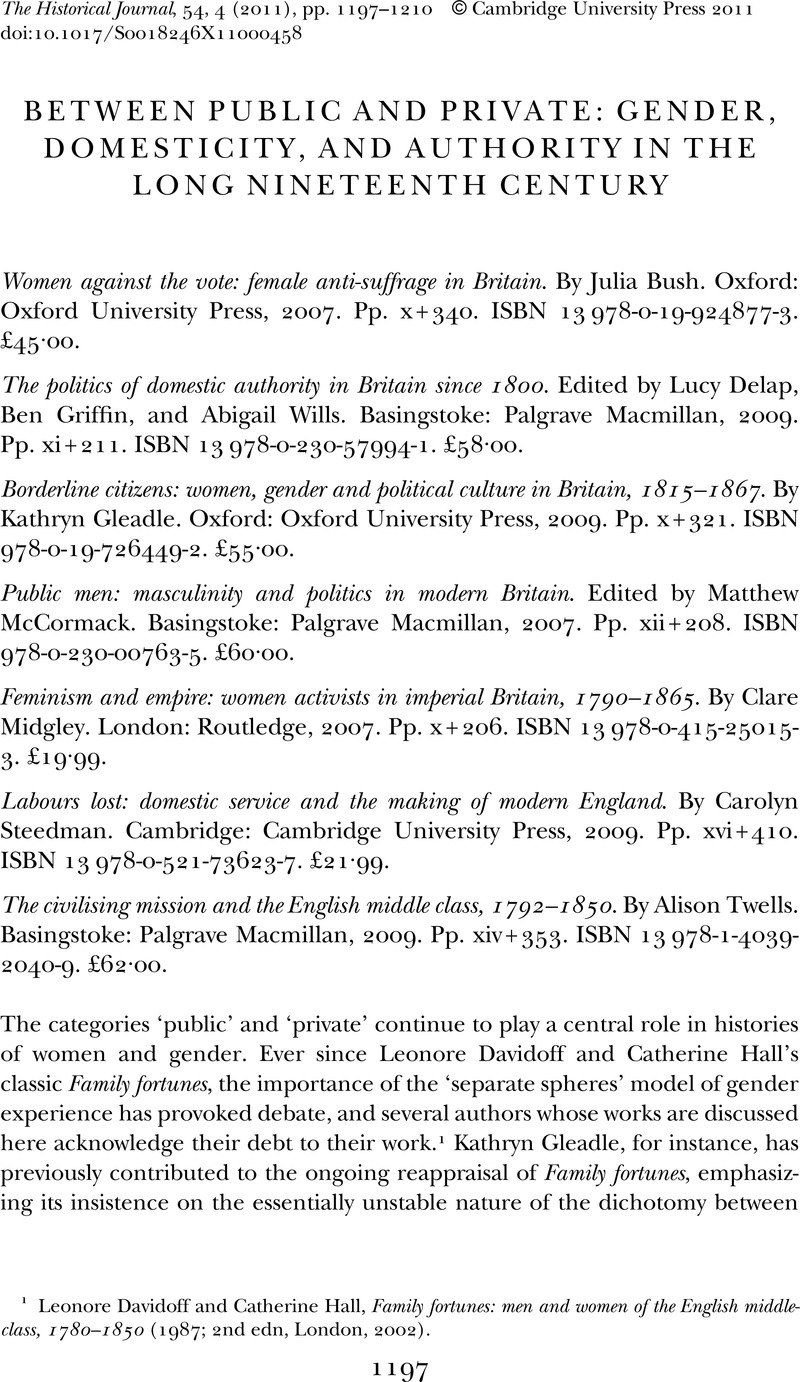Article contents
BETWEEN PUBLIC AND PRIVATE: GENDER, DOMESTICITY, AND AUTHORITY IN THE LONG NINETEENTH CENTURY
Published online by Cambridge University Press: 07 November 2011
Abstract

- Type
- Review Articles
- Information
- Copyright
- Copyright © Cambridge University Press 2011
References
1 Davidoff, Leonore and Hall, Catherine, Family fortunes: men and women of the English middle-class, 1780–1850 (1987; 2nd edn, London, 2002)Google Scholar.
2 Gleadle, Kathryn, ‘Revisiting Family fortunes: reflections on the twentieth anniversary of the publication of Men and women of the English middle class, 1780–1850’, Women's History Review, 16 (2007), pp. 773–82CrossRefGoogle Scholar; Vickery, Amanda, ‘Golden age to separate spheres? A review of the categories and chronology of English women's history’, Historical Journal, 36 (1993), pp. 383–414CrossRefGoogle Scholar.
3 McCormack, ed., Public men, pp. 20–1; Kathryn Gleadle, ‘“Our several spheres”: middle-class women and the feminisms of early Victorian radical politics’, in Kathryn Gleadle and Sarah Richardson, eds., Women in British politics, 1760–1860: the power of the petticoat (Basingstoke, 2000), pp. 115–52; Rendall, Jane, ‘Women and the public sphere’, Gender and History, 11 (1999), pp. 475–88CrossRefGoogle ScholarPubMed.
4 Riley, Denise, Am I that name? Feminism and the category of women in history (Basingstoke, 1989)Google Scholar; Yeo, Eileen, The contest for social science: relations and representations of gender and class (London, 1996)Google Scholar.
5 Twells, Civilising mission, p. 6; Midgley, Feminism and empire, p. 8.
6 Bush, Women against the vote, esp. chs. 3 and 9.
7 Morgan, Simon, A Victorian woman's place: public culture in the nineteenth century (London, 2007)Google Scholar; Smitley, Megan, The feminine public sphere: middle-class women in civic life in Glasgow, c. 1870–1914 (Manchester, 2009)CrossRefGoogle Scholar.
8 E.g. Leonore Davidoff, ‘Regarding some “old husbands’ tales”: public and private in feminist history’, in Worlds between: historical perspectives on gender and class (Oxford, 1995), pp. 227–76.
9 Gleadle, Borderline citizens, pp. 1, 14.
10 Ibid., p. 1; Roper, Michael, ‘Slipping out of view: subjectivity and emotion in gender history’, History Workshop Journal, 59 (2005), pp. 57–72CrossRefGoogle Scholar.
11 Lofland, Lyn H., The public realm: exploring the city's quintessential social territory (New York, NY, 1998)Google Scholar.
12 E.g. Gleadle, Borderline citizens, p. 22; Wahrman, Dror, The making of the modern self: identity and culture in eighteenth-century England (New Haven, CT, 2004)Google Scholar.
13 For a stimulating debate over the value of micro-history, see Brewer, John, ‘Microhistory and the histories of everyday life’, Cultural and Social History, 7 (2010), pp. 87–109CrossRefGoogle Scholar; also the responses by Pat Hudson, ‘Closeness and distance: a response to Brewer’ and de Vivo, Filippo, ‘Prospect or refuge? Microhistory, history on the large scale’, Cultural and Social History, 7 (2010), pp. 375–85, 387–97CrossRefGoogle Scholar.
14 Alana Harris, ‘“A paradise on earth, a foretaste of heaven”: English Catholic understandings of domesticity and marriage, 1945–1965’, in Delap, Griffin, and Wills, eds., The politics of domestic authority, pp. 155–81.
15 Gleadle, Kathryn, The early feminists: radical unitarians and the emergence of the women's rights movement, 1831–1851 (Basingstoke, 1995)CrossRefGoogle Scholar; Midgley, Feminism and empire, p. 8.
16 Bush, Women against the vote, p. 110.
17 Morris, Notably R. J., Class, sect and party: the making of the British middle class (Manchester, 1990)Google Scholar. For women's contribution to middle-class institutions, see Morgan, A Victorian woman's place, chs. 4–6.
18 E.g. ‘May meetings’, Christian Lady's Magazine, 1 (Jan. – June 1834).
19 McCormack's two introductory chapters barely engage with the extensive literature on women and the public sphere.
20 Especially compared with our knowledge of masculine domesticity: Tosh, John, A man's place: masculinity and the middle-class home in Victorian England (New Haven, CT, 1999)Google Scholar.
21 E.g. Riall, Lucy, Garibaldi: invention of a hero (New Haven, CT, 2007)Google Scholar.
22 See Holzer, Harold, Gabor S. Boritt, and Mark E. Neely, The Lincoln image: Abraham Lincoln and the popular print (New York, NY, 1984)Google Scholar.
23 Carlyle, Thomas, On heroes, hero worship and the heroic in history (London, 1841)Google Scholar.
24 Gordon, Eleanor and Nair, Gwyneth, Public lives: women, family and society in Victorian Britain (New Haven, CT, 2003)Google Scholar.
25 Gleadle, Borderline citizens, p. 147.
26 For the role of Gramscian hegemony in Family fortunes, Gleadle, ‘Revisiting Family fortunes’; for hegemony and masculinity, R. W. Connell, Masculinities (Cambridge, 1995).
27 Gleadle, Borderline citizens, p. 108.
28 McCormack writes specifically against Connell's notion of hegemonic masculinity in Masculinities.
29 Matthew Roberts, ‘W. L. Jackson, exemplary manliness and late Victorian popular conservatism’, in McCormack, ed., Public men, pp. 123–42; Siân Pooley, ‘Child care and neglect: a comparative local study of late nineteenth-century parental authority’, in Delap, Griffin, and Wills, eds., The politics of domestic authority, pp. 223–42.
30 E.g. Harrison, Brian, Separate spheres: the opposition to women's suffrage in Britain (London, 1978)Google Scholar.
31 Bush, Women against the vote, p. 203.
32 Steedman, Labours lost, pp. 16–17.
33 Ibid., ch. 1.
34 Ibid., p. 254.
35 Ibid., p. 282.
36 Delap, Griffin, and Wills, ‘Introduction’, in The politics of domestic authority, pp. 1, 4.
37 Ibid., p. 8.
- 1
- Cited by


